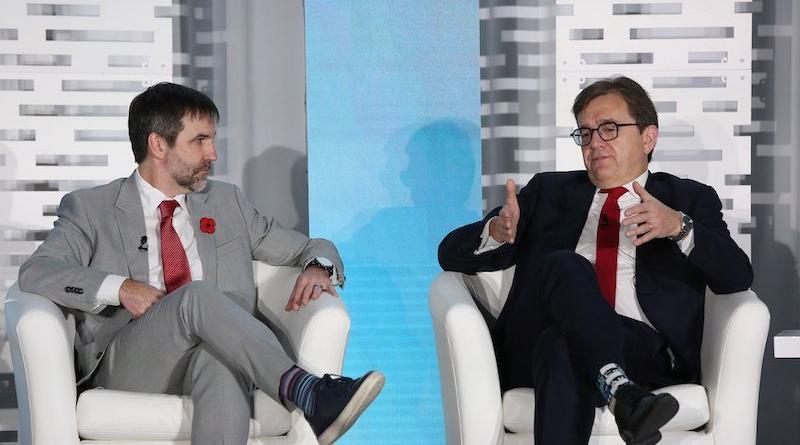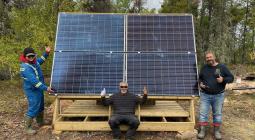Ottawa Must Tell a Better Story on Climate Plan, Address ‘Nitty Gritty’ of Implementation, Ministers Say

The federal government has failed to properly communicate the affordability and job benefits of its emissions reduction plans, but carbon pricing is still a key piece of the puzzle as Ottawa moves from broad strategy to the nitty gritty of implementation, two key cabinet ministers said yesterday, during a moderated discussion at the Canadian Climate Institute annual conference in Ottawa.
“We did the 2019 election on carbon pricing, the 2021 election on carbon pricing and other issues,” and it looks like the next campaign will be more of the same, Environment and Climate Minister Steven Guilbeault told session moderator Catherine Abreu. And “we clearly need to do a better job as a government to communicate many of those co-benefits of fighting climate change, including affordability, including the health and other social benefits of what we’re trying to do.”
“We haven’t necessarily been doing such a good job at this, and we clearly need to up our game,” he added.
Abreu, executive director of Destination Zero and a member of Canada’s Net-Zero Advisory Body, had opened the session by asking Guilbeault and Energy and Natural Resources Minister Jonathan Wilkinson about the challenges of implementation now that the government’s climate policy framework is in place. “What the heck is going on with carbon pricing,” she asked, “and why are we all talking about heat pumps all of a sudden?”
[Disclosure: The Energy Mix Publisher Mitchell Beer serves on the board of Destination Zero, currently as chair.]
Guilbeault replied that in the ideal world, there would have been no need for an exemption to the federal carbon pricing system, but “we don’t live in an ideal world, on many fronts.” The cost of heating oil has increased “substantially faster” than other fuels, it was already more expensive to begin with, “and we realized a lot of people couldn’t go to an alternative because they just couldn’t afford it,” he explained. But in the end, “what we announced two weeks ago will accelerate the reduction of greenhouse gases because we’re putting more money on the table to help people get off home heating oil.”
He added that the pivot from targets to implementation is something he grapples with every day. Some elements of the federal climate plan, like the zero-emission vehicle mandate and the 75% methane reduction target that Prime Minister Justin Trudeau pledged at the United Nations in September, are easier to put into practice because they clearly fall within federal jurisdiction. The Clean Electricity Regulations, in an area where Ottawa “has never historically played a very important role,” are more difficult. But he credited Wilkinson with bringing the file to the point where two provinces have adopted Ottawa’s 2035 deadline to decarbonize the grid, and “I suspect we will have others that will come onboard,” even if not all provinces decide to participate.
Guilbeault cast the recent Supreme Court decision on the federal Impact Assessment Act as “a bit of a shot across the bow to the federal government that says ‘you can do a lot of things when it comes to environment and climate change, but you can’t do everything.’” With provinces holding jurisdiction over the production and use of natural resources, “we have to find the right balance.”
Wilkinson acknowledged that “it’s frustrating for a lot of folks that things don’t happen more quickly”, but pointed to the ZEV mandate as an example of a policy where it was easy to set targets , more complicated to get deployment going. Achieving the mandate will mean building new auto plants and retooling existing ones, building supply chains for vehicles and batteries, bringing on enough affordable, new electric vehicle models to give consumers a full range of choices, getting charging infrastructure in place, and doing it all in step with consumer demand.
“We have more work to do, and you won’t get to 100% sales until you’ve solved the infrastructure and have got down, not only the price point, but the variety of models that can enable choice for people in different income groups,” he said. So “how fast this is evolving is the good news, but the unfortunate reality is that you have to move stepwise or it just doesn’t work.”
Guilbeault said officials have held more than 100 meetings on the upcoming oil and gas emissions cap with multiple provinces, territories, businesses, and other stakeholders, adding that an initial framework for the new rule will be released by the end of the year. Wilkinson said the goal was to come up with a “logical” approach to “get as much reduction as we can without shutting in production,” an outcome that would only make Canada poorer while helping the United States and Saudi Arabia get richer on oil and gas production.
But the latest World Energy Outlook produced by the International Energy Agency points to a major drop in global demand for fossil fuels in the years ahead, indicating that a “rigorous and logical” emissions cap should be achievable.
Both ministers stressed that the country’s response to the climate emergency will need decades of consistent effort, to create certainty for investors and to recognize that many years of climate impacts are already baked into the system.
“We’re often challenged in the House of Commons by people who say, ‘your carbon pricing hasn’t stopped forest fires,’” Guilbeault said. “No, it hasn’t. There’s no light switch anywhere that we can turn on and off.”
But “imagine what we could do in Canada as a nation if we had the same level of collaboration on climate as we do with British Columbia and some other jurisdictions, as opposed to the shouting matches and the constant challenges, including some legal challenges, on many of the things we do,” he told Abreu. “We could be so much further ahead in implementing climate action.”
While he agreed with Environment Commissioner Jerry DeMarco’s finding earlier this week that climate action hasn’t moved far enough, fast enough, Guilbeault said the 8.5% emissions reduction since 20025 reflected in Canada’s 2021 emissions inventory, the latest one available, only tells part of the story. When the current government took office, he recalled, Canada was on track to increase its emissions by 12% by 2030.
“So it’s not just that we’ve reduced. It’s that we’ve eliminated that projected growth in emissions,” he said. “We agree we have to do more. We’re not there yet. But we’ve made tremendous progress, and we have to keep working at it.”
Toward the end of the session, Abreu asked the two ministers to list their next two priorities to close the gap on Canada’s 2030 emissions target. They each came up with three. Guilbeault listed the emissions cap, Indigenous participation in project impact assessments, and methane reductions, noting that methane should be relatively easy for countries to address in concert. If that happens, he said, it will be enough to reduce average global warming by nearly a full degree Celsius by 2100.
“That’s massive, and it’s one of those less complicated things we can do,” he said. “It’s largely about technology.”
Wilkinson listed completion of the federal investment tax credits for clean energy development, noting that the corresponding incentives in the United States have been in place for more than a year. He also prioritized work on carbon contracts for difference to bring some long-term certainty to the federal carbon pricing regime, and economic reconciliation with Indigenous communities.




